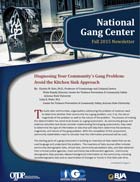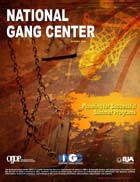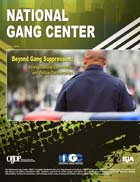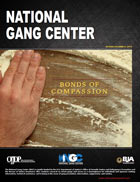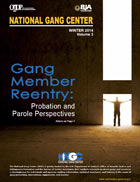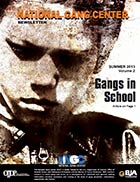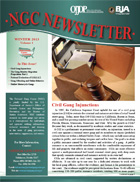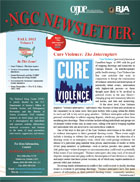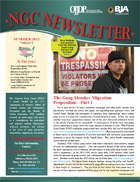Fall 2016 Latest Issue
This issue features articles on improving understanding of and responsiveness to gang-involved girls, success stories of former female gang members, female delinquency and effective programs, resources for human trafficking and policy and programming for girls, and breaking the cycle of violence through the Comprehensive Gang Model and Trauma-Informed Care Public Health Model.
Summer 2016
This issue features articles on gang tattoos, a successful partnership between business and youth job-training programs, review of NGC’s collaborative Webinar, planning for program sustainability, and NGC’s 2015 gang legislation update and Spanish Parents’ Guide to Gangs (Guía sobre las pandillas para los padres) resource.
Fall 2015
This issue features articles on diagnosing a community’s gang problem, Boys & Girls Clubs gang intervention efforts through targeted outreach, promoting adolescent behavioral adjustment in violent neighborhoods, Glen David Curry, using the developmental perspective to better serve youth, and NGC’s Parents’ Guide to Gangs resource.
Spring 2015
This issue features articles on two communities’ strategies for planning successful summer programs, online activity among street gangs, constitutional policing, adolescent development and policing, Highlights of the 2012 National Youth Gang Survey, and updates to the NGC Gang-Related Legislation page.
Fall 2014
This issue features articles on one community’s efforts in curtailing gang-related crime and violence by going beyond gang suppression and building community and police partnerships, law enforcement strategies to reduce gang problems, tips for gang investigators using social media effectively, and NGC’s street gang intelligence online training course.
Spring/Summer 2014
This issue features articles on Homeboy Industries, long-term consequences of adolescent gang membership, NGC Website and resources—Why Youth Join Gangs video and updates to the Gang-Related Legislation page, a YouTube link to “Life Facing Bars: A Gang Prevention Documentary,” and an update from the OJJDP Comprehensive Gang Model Training that was held on March 4–6, 2014, in Dallas, Texas.
Winter 2014
This issue features articles on probation and parole perspectives on gang member reentry, collaboration and information sharing for juvenile justice, OJJDP’s Comprehensive Gang Model training details, and resources offered by OJJDP and BJA.
Fall 2013
This issue features articles on building credibility in street outreach, gang graffiti resources, a G.R.E.A.T. officer spotlight, Highlights of the 2011 National Youth Gang Survey, OJJDP’s Comprehensive Gang Model training, and a report titled Changing Course: Preventing Gang Membership.
Summer 2013
This issue features articles on gangs in school, civil gang injunctions, the 2011 National Youth Gang Survey Analysis, and the OJJDP Strategic Planning Tool.
Spring 2013
This issue features articles on talking to youth about gangs; getting out of and staying out of gangs; and NGC trainer Bruce Ferrell, as well as information on NGC’s updated gang-related legislation page.
Winter 2013
This issue features articles on civil gang injunctions, gang member migration, and social media and gang behavior; an evaluation of the G.R.E.A.T. Program; and information on outlaw motorcycle gangs.
Fall 2012
This issue features articles on the Cure Violence (formerly known as CeaseFire) program; Operation Hardcore, a specialized prosecution unit devoted to violent gang crimes; Street Outreach and the OJJDP Comprehensive Gang Model; and the Massachusetts Shannon Community Safety Initiative, as well as a report titled Gang Homicides From Five U.S. Cities.
Summer 2012
This issue features articles on gang member migration; effective gang reentry; prevention and intervention services for gang-affiliated girls; and dealing with gang violence in medical facilities.
Spring 2012
This issue features articles on challenges schools face when dealing with anti-gang policies; comparing gang activity and the falling crime rate; North Carolina’s approach to youth gangs; and the G.R.E.A.T. Program’s international efforts in Central America.




